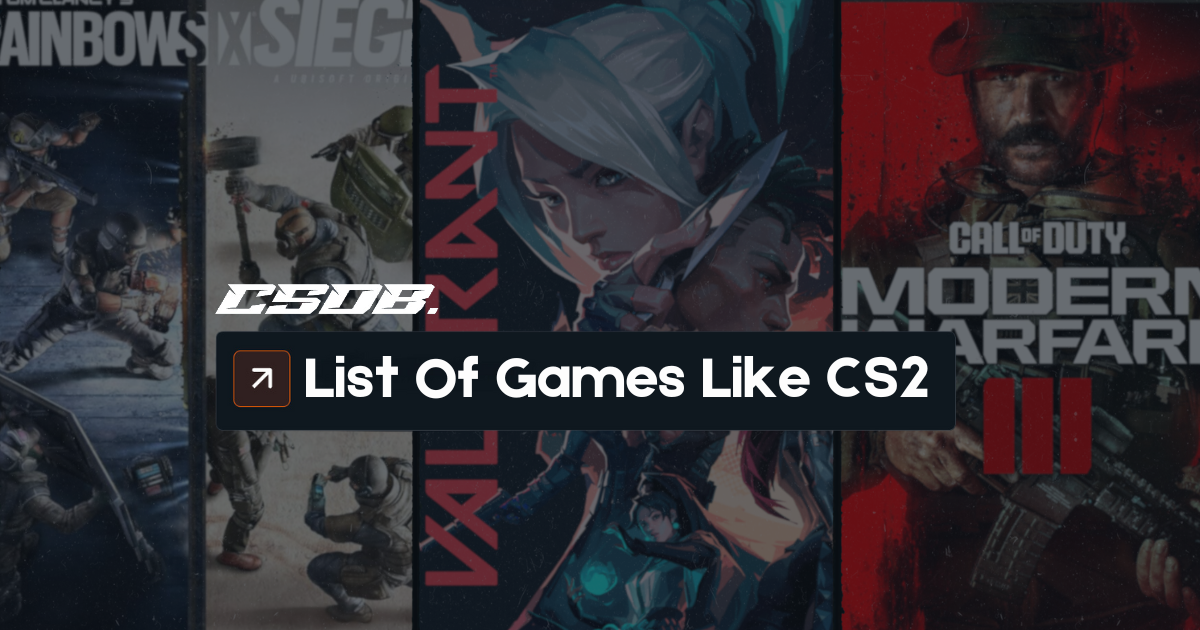Counter-Strike has been one of the biggest and most successful first-person shooter franchises of all time. With over 20 years atop the industry, it seems like nothing will ever change that fact. There are, however, other titles in the same space that serve as competition or simply a nice alternative to CS at times.
Tom Clancy’s Rainbow Six Siege

Similarities:
- Both games emphasize coordinated assaults and strategic defense. Communication and well-oiled plays are key to victory.
- Completing goals like planting a bomb (CS2) or securing a hostage (R6S) takes priority over pure kill counts.
- A single well-placed shot can take down an opponent, making every bullet count and rewarding precision aim.
- Both have thriving esports scenes, demanding mastery of maps, weapons, and tactics.
Differences:
- CS2: Faster paced, with an emphasis on quick reflexes and map control through strategic smokes and grenades.
- R6: Slower, methodical approach. Breaching walls, reinforcing positions, and utilizing gadgets create a more layered strategic experience.
- CS2: Economy system allows players to buy weapons and equipment each round, adding a resource management layer.
- R6: Operators with unique gadgets and abilities (Thermite breaching walls, Sledge hammering through floors) create a deeper strategic dimension.
- CS2: Simpler layouts with fewer destructible environments, encouraging map memorization and predictable firefights.
- R6: Highly destructible environments with multi-floor buildings and complex layouts. Players need to adapt strategies based on a constantly changing environment.
VALORANT

Similarities:
- Victory hinges on coordinating attacks, defending positions, and utilizing each player’s strengths. Communication and planning are crucial for outsmarting the opposing team.
- Rounds begin with limited funds to purchase weapons, armor, and grenades. Careful spending and clutch kills to secure dropped weapons fuel future rounds.
- One team plants a bomb, the other aims to defuse it or eliminate the planters. This high-stakes objective creates intense moments and strategic tension.
- Ranked modes push players to hone their skills and climb the ladder. Both games boast thriving esports scenes with professional leagues and tournaments.
Differences:
- Agent Abilities vs. Raw Skill: VALORANT injects a layer of complexity with unique characters (Agents) wielding special abilities. These abilities can block vision, create one-way smokes, or even teleport players. CS focuses purely on weapon mastery and map knowledge.
- Learning Curve: Counter-Strike’s recoil patterns and spray control have a notoriously high skill ceiling. Mastering weapon mechanics takes dedication. VALORANT’s abilities offer an alternative path to impact, making it slightly more accessible for newcomers.
- Art Style: VALORANT embraces a colorful, cartoonish aesthetic. CS2 prioritizes a more realistic visual style, mirroring actual weaponry and environments.
- Economy and Pacing: CS2’s economy allows for faster weapon upgrades, leading to quicker, more aggressive gameplay. VALORANT’s economy is tighter, encouraging methodical play and strategic use of abilities.
- Anti-Cheat: VALORANT utilizes an anti-cheat that’s generally considered more robust than Counter-Strike’’s system. This can make a significant difference for players seeking a fair competitive environment. As of June 2024, CS2’s anti-cheat has come under scrutiny for underperforming.
Call of Duty

Similarities:
- Working together with your team to achieve goals like planting a bomb or securing an area is a core part of the experience.
- Both games offer some form of competitive ranking system. While Counter-Strike’s ranking is more established and ingrained in the core experience, Call of Duty often utilizes skill-based matchmaking to pit players of similar abilities against each other.
- Knowing the ins and outs of the maps is crucial in both games. Learning strategic locations like bomb sites in Counter-Strike or advantageous firing positions in Call of Duty gives you a significant edge.
Differences:
- Game Modes: Call of Duty boasts a wider variety of game modes. It features single-player campaigns that take you through epic storylines, often with a historical backdrop. Additionally, Call of Duty may include unique modes like the popular “zombies” survival mode, which is absent from Counter-Strike 2.
- Competitive Depth: Counter-Strike 2 leans heavily on competitive multiplayer, fostering a high skill ceiling. Matches are characterized by rounds with limited respawns, demanding strategic thinking and precise execution. Call of Duty, on the other hand, often features faster-paced action with more respawns, catering to a wider range of skill levels.
- Pacing and Flow: The gameplay pace in Call of Duty is typically faster. Larger maps with vehicles often encourage a more mobile, aggressive playstyle. Conversely, Counter-Strike 2 emphasizes a more tactical approach. Smaller maps with choke points lead to slower, more methodical movement and team coordination.
- Weapon Customization: Call of Duty allows for customization of weapons with attachments and perks, while Counter-Strike 2 features a more standardized weapon selection, with the focus being on mastering the core mechanics of each gun.
Team Fortress 2

Similarities:
- There’s more to these games than just racking up kills. Completing objectives like capturing control points or planting/defusing bombs is essential for winning rounds.
- Matches are divided into rounds with win conditions. The first team to win a set number of rounds emerges victorious.
Differences:
- Objectives: While both involve shooting, the goals differ. TF2 revolves around capturing control points or escorting a payload. CS:GO focuses on eliminating the opposing team or defusing/planting a bomb.
- Classes: TF2 features unique character classes with distinct abilities. A Scout flanks enemies with his speed, while a Heavy lays down suppressing fire. CS:GO emphasizes weapon skill and strategy. Players choose from a variety of weapons but everyone has the same basic abilities.
- Graphics: TF2’s art style is vibrant and humorous, with a loose and wacky atmosphere. CS:GO leans towards realism with a focus on tactical plays and precise gunfights.
- Fast-Paced Action vs. Methodical Movements: TF2’s gameplay is faster. Movement abilities like double jumps and rocket jumps allow for high-mobility action. CS:GO is slower paced, rewarding strategic positioning and map awareness.
Rate this article


